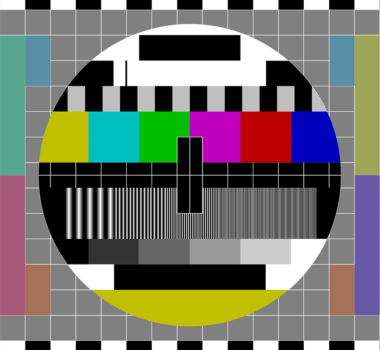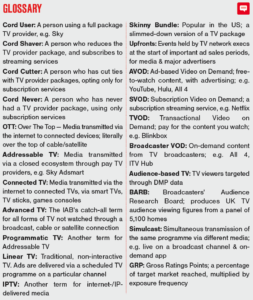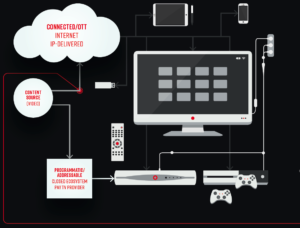Do Not Adjust Your Connected Devices
by Lindsay Rowntree on 25th Oct 2017 in News

The TV ecosystem can seem mind-boggling. Whether you’re a cord user, cord shaver, cord cutter, or cord never, how you consume TV and how you are targeted is changing beyond all recognition.
Brave new world
It was only a few years ago, when the prospect of advertisers being able to target people down to a household level through their Sky boxes seemed impressive and terrifying, in equal measures. You’re sitting on the sofa with your labradoodle, watching an ad for dog food, while your neighbour is sitting next to the baby monitor, being targeted with a nappy ad. While still a very popular form of targeting, it seems elementary by today’s standards.
With companies able to help brands run a mobile ad at the exact time you watch Alonso score the winning goal for Chelsea on Super Sunday; or use ambient audio signals to determine which programme and channel a person is watching at any one time, the opportunities for enhanced targeting and data capturing are myriad.
If you’re an Amazon Echo user, have you also ever wondered why your Echo reacts to Amazon’s Alexa TV ads, but doesn’t actually speak? No-one knows for sure, and it’s likely to do with audio frequency, to ensure Alexa doesn’t respond every time an Amazon TV ad plays. Your Echo runs constant recognition technology, so what if Amazon is using it to determine what you’re watching, and when, to improve audience targeting?
Not another acronym
But let’s not get ahead of ourselves, as it seems the TV ecosystem causes a lot of confusion across the ad industry, not helped by the fact that each market has an entirely different setup.
There are a lot of terms and acronyms used in TV advertising, many of which mean the same thing, and many of which are incorrectly used interchangeably. If you’re still not sure, our glossary is a starting point.

Source: The Wire magazine, issue 05
Over the top
Let’s focus on OTT, or connected TV – terms which tend to be used interchangeably, but do carry slight differences. OTT includes connected TV, as well as mobile and tablet, with some debate over whether desktop should also sit in that bucket. If you’re watching TV content on a mobile device, this is considered to be OTT. However, if you then stream that content to your TV via a TV stick, such as Amazon Fire, it then becomes connected TV. VOD categorises anything on connected TV, delivered on an impression-basis.
While still relatively small, versus traditional TV advertising, which was a £4.7bn business in the UK in 2016, VOD is experiencing growth surges. In 2016, it saw a 12.6% ad spend growth (versus a decline of 0.5% in traditional TV), equalling £197m. It is forecast to grow a further 13.7% this year, whereas traditional TV ad spend is expected to fall a further 1.4%. Is VOD usurping budget from traditional TV? If you speak to the advertisers, not really. While everyone would expect it to be an obvious transition, the two ends of the TV spectrum do hold rather different roles. It’s actually more likely this growing advanced TV budget is coming from areas like print, which saw a 13% year-on-year drop in UK ad spend in 2016.

Source: The Wire magazine, issue 05
It’s a young person’s game
While VOD may seem small, as a like-for-like comparison with UK viewing habits, it’s very much in line. Only 4% of consumption is via broadcaster VOD, versus 60% live TV, and 11% playback TV. However, a rather different picture is painted by age range. Research by Ofcom found that 75% of 16-24 year-olds use public-service broadcaster on-demand and streaming services, against a base of 67% across all adults.
ITV’s summer success, Love Island, was watched live via it’s on-demand platform, ITV Hub, by 30% of viewers. This was a surprise to everyone, not least to ITV; as why would you actively choose to watch something on your mobile device when you are probably sitting in the same room as a TV? Ofcom’s research backs this up, finding that younger age groups are more likely to use devices other than the TV set to view content, with 77% using laptops or PCs, and 64% using smartphones. While this age group is the most likely to view video content outside the home, 92% said the majority of content they consume is at home, just not necessarily on a TV set. It seems that not only are mobile devices being considered as a second TV, but that on-demand services aren’t all about catch-up.
Seventy-five percent of the UK’s 16-24 year-olds are registered on the ITV Hub, up 50% from December 2016, indicating that the trend of consuming TV content via a connected device, rather than traditional broadcast, is a growing one among the younger generation of ‘cord cutters’ and ‘cord nevers’. As SpotX’s managing director of UK and southern Europe, Léon Siotis, points out, big TV shows, like Love Island, Britain’s Got Talent, or X Factor still have a huge draw, but viewers might be gravitating towards watching them on live-streamed simulcasts, rather than via traditional broadcast. “User experience with connected TV platforms is becoming so similar to the traditional Sky box, that people may not think they’re consuming connected TV content, but if I’m watching a simulcast via an OTT device, I don’t even know; I would assume it’s the same, because of the way the content is being delivered.”
US network dominance
In the UK, pay-TV platform operators still hold a lot of weight, responsible for generating 46% of total TV industry revenue in 2016 and, despite a growth of 15% on ad-funded video content from services such as ITV Hub, its proportion of total still remains small. It’s a very different landscape in the US, where ‘cord cutters’ and ‘cord nevers’ are much more prevalent, due to the comparative lack of free-to-air content, resulting in hefty TV package costs.
Cable packages in the US cost the average consumer USD$92 (£72) per month, not including compulsory add-ons, such as set-top box rental charges. Many are paying upwards of USD$200 (£156) per month to access all channels. The rise of platforms like Hulu, which is a mixture of AVOD and SVOD, is unsurprising from a nation that is fed up with paying exorbitant monthly fees to access cable TV content littered with irrelevant and annoying ads.
More recently, the ‘skinny bundle’ has entered the scene, with Verizon being the first to offer a slimmed-down package costing just USD$55 (£43) per month. And everyone’s getting involved. As well as Dish Network’s Sling TV (akin to Sky’s Now TV in the UK), and AT&T’s DirecTV Now, Sony Playstation launched the PS Vue, Hulu recently launched its live TV offering, and even Google is getting in on the act with the announcement of YouTube TV, offering 44 channels for USD$35 (£27) per month.
Speaking in his keynote at ExchangeWire Live in New York, The Trade Desk CCO, Brian Stempeck, shared some statistics, which show just how different the US market is from its European counterparts. Seventy-four percent of US households have connected TVs or devices, with it accounting for 8.1% of total TV viewing for 18-49 year-olds, which is double the UK, and grew 65% from the previous year. Stempeck believes skinny bundles will only accelerate this growth further. “If you look at most consumption today on any kind of IPTV, you’re really talking about Netflix, Hulu, Amazon – a lot of models that actually aren’t ad-supported”, explains Stempeck. “Most of these skinny bundles will be ad-supported, along with the subscription fee. That means when you go from 5% to 8% of total TV viewing being connected within a year, [the skinny bundle] accelerates that.”
Disruption
The US does have a problem with fragmentation and the lack of scale that comes with that. When you can access one TV show across 15 different platforms, it becomes a challenge for the consumer and for the advertiser. DSPs, such as The Trade Desk, are able to help with this fragmentation, by aggregating connected-TV inventory. This is less of a problem for the UK, as AVOD is still largely dominated by a select few: Sky, ITV, and Channel 4. There are new players in the UK market, which could increase fragmentation. But, as live TV is still highly valued and draws in large audiences, whether through broadcast or streamed OTT, it does keep complexity down. One new player in the UK, which is taking on the current broadcaster VOD platforms, is TVPlayer. It allows you to stream live TV onto a connected device for free. TVPlayer is AVOD, with ads delivered in-app and on-site, as well as in-stream. It also has an SVOD offering, whereby for a monthly fee of £5.99, you can also access its on-demand library, as well as remove in-app and on-site ads. Its closest competitor is probably Now TV, and is an early version of the skinny bundle for the UK, a market that doesn’t necessarily need them, but could be swayed by a disruptive upstart, looking to challenge the model.
One company that is transforming the TV landscape globally is, of course, Netflix. Its penetration is significant and, if it wanted to, it could turn OTT advertising on its head overnight. There is much speculation as to whether Netflix will go down the Spotify route, offering an ad-free subscription model, as well as an ad-funded model. Netflix has a good thing going and, as Siotis says, while ad-funded TV is a very exciting area, it is a pain: “It’s hard to run an ad-funded business. Going down the route of building sales teams and managing how you work with buyers is a huge step, versus a subscription service, when you don’t have to.” Many are inclined to agree with Siotis’ view, but when you hear that its show The Crown cost USD$130m (£116.9m) to make, and the second season will cost even more, you do have to question how Netflix intends to continue funding this type of original content, relying purely on subscriptions.
European markets to watch
Looking outside the UK and US, there are interesting developments in other markets. In France last year, more TV was watched via mobile or tablet, than on any other device – 38.9% versus 31.6% on connected TV. France has an interesting landscape, dominated by telcos like SFR. They offer bundles with mobile, landline, internet, and TV all together, and ad delivery is completely different, as the telco acts as the media owner. It’s a big IPTV market, but it can’t be considered OTT, as it’s delivered through the telcos’ private network.
The Nordics is a region to watch, and it actually leads the SVOD market in Europe, representing almost 20% of all SVOD subscriptions in the region. All of the major broadcasters have developed OTT apps, including Viaplay’s app, which is 10-years old, so it’s an established market that is happy to embrace new trends and technologies.
IPTV is also gaining popularity in Spain, with a penetration rate of 22%, versus 14% across the rest of Europe. Movistar made the leap from satellite to IPTV, and now boasts three million subscribers to its IPTV service, versus only 900,000 through its satellite service. It’s a market that is gaining traction, but is coming from a slightly lower base than the more established markets of UK, France, and Germany.
Turf wars
Where does OTT sit? It’s digital, but it’s TV – so does it sit with the programmatic teams, the audiovisual (AV) teams, or is it handled by the traditional TV guys? It depends who you ask.
As SpotX’s Léon Siotis points out, the connected TV ecosystem lands within the digital scheme of things and, in most agencies, the AV teams are controlling VOD and they will direct budget towards both linear and digital. The Trade Desk’s Brian Stempeck refers to the turf war happening in many agencies in the US: “Too often I hear people in media say, ‘well that’s a legacy, old-school TV buyer, he knows nothing about programmatic.’ Or the inverse, ‘the programmatic buyer knows nothing about TV.’” However, he does point out that there are some great examples of where both sides come to the table to share their expertise, with digital buyers bringing expertise on leveraging the tech stack and TV buyers sharing their vast knowledge on pricing.
Speaking at ExchangeWire Live in New York, Josh Martin, EVP, Performics, points towards the differing skillsets between traditional and digital in the current agency model: “In TV, planning and buying are so separate; they are siloed in discipline and function. Digital is more mixed, with planning and buying more combined in talent and person.”
With clients increasingly demanding consistency across digital and traditional TV, buying teams are trying to work out how to deliver on the request. But, as Adam Heimlich, SVP programmatic, managing director of HX, Horizon Media clarifies, TV teams aren’t about to log into a DSP: “Realising that the traditional TV marketplace is 7-10-times bigger than the digital marketplace, means the traditional marketplace will probably change the entire landscape more than the other way around. The cultural difference is optimisation.”
When is an audience not an audience?
In the UK, we have BARB; in the US, Nielsen. Without even getting into the argument about panel-based TV measurement for broadcast television, measurement in the connected TV space is hugely flawed.
In the US, you largely can’t measure a GRP today when running over-the-top activity. TV has been transacted by the GRP for a long time, and to not be able to quantify incremental GRPs, when running on the likes of Hulu or Roku (which powers Sky’s Now TV Smart Box in the UK) in the US, is a problem. “You are buying 100 GRPs when doing an upfront”, confirms The Trade Desk’s Stempeck. “You need to be able to have an apples-to-apples comparison if you’re going to see scale move into the connected space. We’ve got to be able to speak both languages: programmatic and the traditional GRP.”
BARB only measures desktop and mobile, and classifies it as OTT, so anyone watching content via a Chromecast or Now TV is not being measured. There are plenty of smart measurement companies out there, which help to close that gap, and agencies are building dedicated teams to try to align these data points; but when the measurement standard is so far off the mark, it definitely makes it an interesting space to play for.
Advertisers investing in the connected-TV space still demand reach and frequency from their agencies, despite it not being readily available, as they want to be able to directly compare the two. Agencies can work with this and can supply augmentations of base reach, but the audience targeting across the two is apples to oranges. If you’re buying linear TV, you might reach 40-50% of your target audience; whereas, in connected TV, advertisers need to understand they’re buying an audience that is 100% on-target, as they’re only paying when their target audience is reached.
Horizon Media’s Heimlich explained at ExchangeWire Live why he believes the easiest way to achieve unified measurement is to start with a digital-first advertiser. While there are developments happening in-market to help forecast reach and frequency for connected TV in linear TV standards, it’s fundamentally a currency difference, and it can be a difficult one for the advertiser to understand, because they’re buying an audience on TV and are used to paying per GRP. By encouraging an advertiser heavily invested in digital to explore the connected-TV space, measurement and performance can be much more easily aligned.
Remember what makes TV special
There are a couple of things to remember, though. While growing, the connected-TV space is still tiny in comparison with traditional TV and, ultimately, as an advertiser, it depends on who your target audience is and what product you’re trying to push out to the market. If your target audience is 55+, you will not get the same reach, however you choose to measure it on connected TV that you might upfront, because that’s not necessarily where your audience is – research in the UK shows this age group has by far the lowest OTT penetration and, by comparison, it indexes highly on reach across broadcast TV.
For agencies targeted with increasing the percentage of digital versus traditional billings, moving budget into connected TV, and running it through the trading desk, is extremely appealing. But as SpotX’s Léon Siotis explains, it’s not the right solution for everyone, and we shouldn’t discard the magic of television: “TV is an amazing medium. It’s hard to capture 10 million people at one time.” And big-budget advertisers should remember that.
Connected TV provides opportunities for smaller advertisers, where a nationwide campaign may not be as effective, or financially feasible, but hyper-targeting has its limitations. The power of TV is the creative and the aspiration factor, and focusing too much on granular targeting over and above a memorable TVC, that could stay with you for twenty years, could ultimately be of detriment to your brand. It’s something the display community has started to realise over the years, and hopefully TV will get there too.
First published in The Wire, Issue 5








Follow ExchangeWire